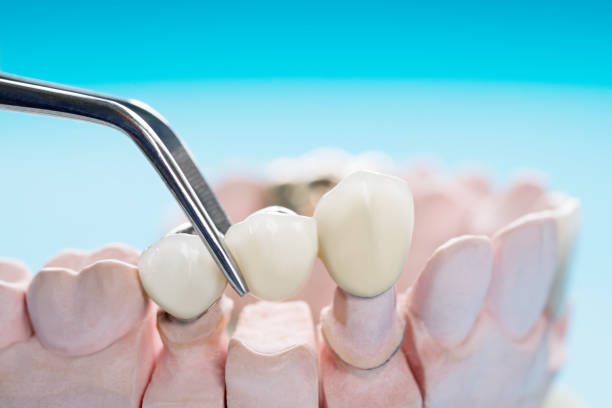A dental bridge is a fixed/permanent restoration designed to replace one or more missing teeth in the mouth. Dental bridges mimic the look, shape, and even functions of natural teeth. They are also personalized to fit snugly for individual patients.
Most patients only need a simple dental bridge comprising one or more “teeth” fused to fit the open space where the missing teeth were located. However, a patient may also need what’s known as full mouth rehabilitation. In full mouth rehabilitation, several dental bridges are used to restore the patient’s dental formula.
Different dental bridges are made from different materials. While the majority are made from porcelain, higher-quality, more expensive options made from alloys and gold are available. Front teeth bridges are almost always made of porcelain to match the natural color of human teeth.
Dental Bridges vs. Dentures vs. Dental Implants
It’s important to note the difference between dental bridges, dentures and, and dental implants. While they both refer to cosmetic dentistry procedures, they aren’t the same thing.
-
Dental bridges
Dental bridges are permanent fixtures designed to replace missing teeth. Once installed, they become permanent fixtures that you can’t remove and replace as you wish. Also, bridges function like the missing teeth. You can chew and bite just as with regular teeth. You can also speak naturally. Dental bridges are typically replaced every 10 years.
-
Dentures
Dentures aren’t permanent fixtures. Instead, they’re more of a cosmetic solution. If you hear people talking about false teeth, they’re mostly discussing dentures. They are supported by supporting soft and hard tissues of the oral cavity and are removable as you wish. They also come in partial or complete options. Unlike dental bridges, dentures often affect speech as well as eating. You need to replace them every five or so years.
-
Dental implants
Finally, dental implants are the most permanent solution for missing teeth. Unlike bridges typically held in place by the existing teeth surrounding the missing teeth, dental implants stand on their own metal roots. Once the metal implant post/root is implanted (the process involves surgery), a period is provided for the jawbone to grow into and unite with the implant.
Pros and Cons of Dental Bridges
According to the American Academy of Cosmetic Dentistry (AACD), dental bridges are the sixth most common dental procedure in the US. However, they also come with a few downsides.
Dental bridge benefits
- It’s a quick- straightforward procedure
- It’s affordable
- Has a short recovery time
- Relatively permanent (compared to dentures)
- It doesn’t affect chewing or eating
- The procedure doesn’t affect speech
Dental Bridge Drawbacks
- It doesn’t look as natural as implants
- Must be replaced periodically
- Can damage the existing surrounding teeth
Types of Dental Bridges
Dental bridges are available in four main options, i.e., traditional bridges, cantilever bridges, Maryland bridges, and implant-supported bridges.
1. Traditional dental bridges
Traditional bridges are the most common type of dental bridge. They consist of one or more pontic (fake tooth) and are held in place by dental crowns, also known as abutments, cemented onto the teeth adjacent to the missing tooth/teeth.
While they are strong enough to replace molars, traditional bridges have one major downside – the dentist must remove a substantial portion of the enamel on the adjacent teeth to cement the dental crowns. This creates a significant problem considering that enamel doesn’t re-grow.
2. Cantilever dental bridges
Cantilever bridges are a slight variation of traditional dental bridges. They attempt to resolve the issues associated with enamel removal by supporting the fake tooth/teeth on only one side rather than both sides.
While removing the enamel on only one side of the bridge presents some advantages, this configuration presents a few fresh challenges. According to the National Institute of Health, the biggest issue is loosened crowns.
3. Maryland dental bridges
Maryland dental bridges eliminate the problem of removing enamel to cement the dental bridge. Instead, the bride is held in place using a metal or porcelain framework. This way, the dentist doesn’t need to file the adjacent teeth.
Unfortunately, Maryland bridges tend to be weak. The strength of the bridge depends a lot on the strength of the resin that holds it in place. Also, the framework can get in the way of the gums or your bite.
4. Implant-supported dental bridges
The best solution if you’re considering dental bridges is an implant-supported bridge. Instead of relying on crown or framework support, implant-supported bridges are supported by implants – typically one for each missing tooth. Implant-supported dental bridges feel very secure and comfortable, just like natural teeth. They also last the longest of the four bridge types.
Unfortunately, implant-supported bridges require two surgeries which can take up to five months to complete. They are also the most expensive of the four procedures.
The Choice is Yours
All four dental bridge types are good enough to replace missing teeth. They all restore functionality, allowing you to eat and bite as usual while also improving dental aesthetics. However, if the budget allows, implant-secured bridges are the best.


